
It's about how to be a professional English reader.
- Subject:
- Languages
- Material Type:
- Student Guide
- Author:
- Samih Alkhouly
- Date Added:
- 04/25/2023

It's about how to be a professional English reader.

The documents included in this lesson come from The North Carolina Experience collection of Documenting the American South and specifically focus on African Americans and race relations in the early 20th century. The lesson juxtaposes accounts that relate to both the positive improvements of black society and arguments against advancement. Combined, these primary sources and the accompanying lesson plan could be used as a Document Based Question (DBQ) in an advanced US history or African American history course.
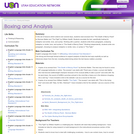
In this set of lessons which extend over several days, students read excerpts from "The Death of Benny Paret" by Norman Mailer and "The Fight" by William Hazlitt. Students annotate the text, specifically looking for metaphor and simile, tone, and syntax. Working with a partner, students write three paragraphs, analyzing metaphor or simile, tone, and syntax in "The Death of Benny Paret." Working independently, students write one paragraph, choosing to analyze metaphor or simile, tone, or syntax in "The Fight."
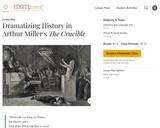
By closely reading historical documents and attempting to interpret them, students consider how Arthur Miller interpreted the facts of the Salem witch trials and how he successfully dramatized them in his play, "The Crucible." As they explore historical materials, such as the biographies of key players (the accused and the accusers) and transcripts of the Salem Witch trials themselves, students will be guided by aesthetic and dramatic concerns: In what ways do historical events lend themselves (or not) to dramatization? What makes a particular dramatization of history effective and memorable?

This unit plan was designed in order to instruct students in the Kittitas Valley about the contributions and perspectives of the Kittitas Band of the Yakama Nation. This unit plan has students use primary and secondary sources, inquiry, videos and lecture to plan and conduct an oral history interview with a Kittitas Band member. If tribal members of the Kittitas are not avaiable for interview, there is a sample video of an interview with Kittitas member Allen Aronica. Students can use this video instead of conducting an oral history interview for the final lesson.

The 11th grade learning experience consists of 7 mostly month-long units aligned to the Common Core State Standards, with available course material for teachers and students easily accessible online. Over the course of the year there is a steady progression in text complexity levels, sophistication of writing tasks, speaking and listening activities, and increased opportunities for independent and collaborative work. Rubrics and student models accompany many writing assignments.Throughout the 11th grade year, in addition to the Common Read texts that the whole class reads together, students each select an Independent Reading book and engage with peers in group Book Talks. Students move from learning the class rituals and routines and genre features of argument writing in Unit 11.1 to learning about narrative and informational genres in Unit 11.2: The American Short Story. Teacher resources provide additional materials to support each unit.

In this unit, students will take a look at the historical vision of the American Dream as put together by our Founding Fathers. They will be asked: How, if at all, has this dream changed? Is this dream your dream? First students will participate in an American Dream Convention, acting as a particular historical figure arguing for his or her vision of the American Dream, and then they will write an argument laying out and defending their personal view of what the American Dream should be.
ACCOMPLISHMENTS
Students read and annotate closely one of the documents that they feel expresses the American Dream.
Students participate in an American Dream Convention, acting as a particular historical figure arguing his or her vision of the American Dream.
Students write a paper, taking into consideration the different points of view in the documents read, answering the question “What is the American Dream now?”
Students write their own argument describing and defending their vision of what the American Dream should be.
GUIDING QUESTIONS
These questions are a guide to stimulate thinking, discussion, and writing on the themes and ideas in the unit. For complete and thoughtful answers and for meaningful discussions, students must use evidence based on careful reading of the texts.
What has been the historical vision of the American Dream?
What should the American Dream be? (What should we as individuals and as a nation aspire to?)
How would women, former slaves, and other disenfranchised groups living during the time these documents were written respond to them?
BENCHMARK ASSESSMENT: Cold Read
During this unit, on a day of your choosing, we recommend you administer a Cold Read to assess students’ reading comprehension. For this assessment, students read a text they have never seen before and then respond to multiple-choice and constructed-response questions. The assessment is not included in this course materials.

The 12th grade learning experience consists of 7 mostly month-long units aligned to the Common Core State Standards, with available course material for teachers and students easily accessible online. Over the course of the year there is a steady progression in text complexity levels, sophistication of writing tasks, speaking and listening activities, and increased opportunities for independent and collaborative work. Rubrics and student models accompany many writing assignments.Throughout the 12th grade year, in addition to the Common Read texts that the whole class reads together, students each select an Independent Reading book and engage with peers in group Book Talks. Language study is embedded in every 12th grade unit as students use annotation to closely review aspects of each text. Teacher resources provide additional materials to support each unit.

In this short unit, students will spend three lessons exploring some of Abraham Lincoln's speeches. Students will explore Lincoln's themes and consider how they address the issues of his time, and they'll analyze the literary and rhetorical devices he used to express his ideas.
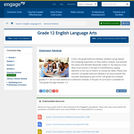
In this 12th grade Extension Module, students can go deeper into analyzing arguments, as they outline, analyze, and evaluate the claims that Michelle Alexander makes in|The New Jim Crow: Mass Incarceration in the Age of Colorblindness, paying attention to her use of rhetoric to convey her ideas. Please note that this 12th grade Extension Module is an extra module that has been developed as part of the 12th grade ELA modules; grades 9-11 do not have additional or extension modules. A full year of curriculum is available for 12th grade through modules 1-4.
Find the rest of the EngageNY ELA resources at https://archive.org/details/engageny-ela-archive .

Local government is the government of people’s daily lives. It is your local government that you will interact with most throughout your daily life. In this seminar, you will learn about the role of local government in a community. By the end of this seminar, you will be able to discuss how local government and community members work together. You will be able to compare the structure of local government as a whole to the structure of the government in your community.Standards5.1.4 C - Explain the principles and ideals shaping local and state government.
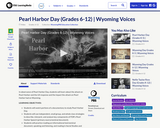
Students will learn about the attack on Pearl Harbor and the US response of the Pearl Harbor Day observance.
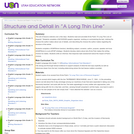
This set of lessons extends over a few days. Students read and annotate Ernie Pyle's "A Long Thin Line of Anguish." Students complete a SAYS/DOES graphic organizer, working on summarizing the text, noticing the choices the author makes about use of details, and describing the choices the author makes regarding the structure of the article.
Students complete a SOAPStone handout, identifying subject, occasion, author, purpose, speaker and tone (SOAPStone is a pre-AP/AP strategy). Students develop claims about why Ernie Pyle makes the writing choices he makes. Students write an informal, free-response style assessment about the impact of Pyle's choices.
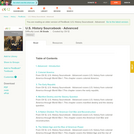
From CK-12, U.S. History Sourcebook - Advanced covers U.S. history from Colonial America through World War I. This book provides high school U.S. History teachers and students with sets of primary and secondary sources about important topics. Some teachers will use it as a supplement to a traditional textbook. For those looking to leave the textbook behind entirely, it will provide a course with basic structure and continuity, and will reduce the burden of finding new primary sources for each class meeting. However, it is not yet comprehensive enough to meet the coverage requirements of, for example, an Advanced Placement test.